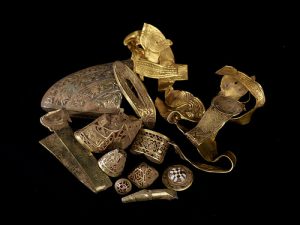The recent discovery of the biggest hoard of gold ever found in Britain has brought tears to the eyes of experts and amateurs alike. Terry Herbert stumbled upon the huge trove of Anglo-Saxon treasure – worth at least £1 million – while metal detecting in a Shropshire field.
Herbert isn’t the only amateur to have hit the jackpot. Several finds by metal detectorists have stunned archaeologists and proven that the hobby can have surprisingly spectacular – and lucrative – results.
Here we round up 10 of the top artefacts discovered by metal detector in Britain.
1. The Shrewsbury Hoard, 2009
“Easy, this metal detectoring lark,” thought amateur treasure hunter Nick Davies to himself, probably, after on his first-ever sweep discovering a clay pot crammed with over 10,000 Roman coins. He gets the top spot for sheer flukiness.
2. The Winchester Hoard, 2000
Retired florist Kevan Halls was responsible for this incredible metallic haul, which included 1kg of intricate gold jewellery, and left archaeologists scratching their heads, since the artefacts are Roman-made yet predate the invasion of Britain.
3. The Vale of York Hoard, 2007
This 1,000-year-old set of Viking jewels and coins – unearthed by a father-son metal detecting team near Harrogate – was bought by the British Museum and the Yorkshire Museum in York in August 2009 for a cool £1.1 million.
4. The Domitianus Coin, 2003
Just a single coin, but one that hit the £47,000 jackpot for metal detectorist Brian Malin, by proving the existence of the little-known emperor Domitianus, or Domitian II. Only one other coin bearing his image had previously been found, in France, and it was thought a fake until this turned up. It was bought as part of the Chalgrove II hoard by the Ashmolean Museum in 2005.
 5. The Hoxne Hoard, 1992
5. The Hoxne Hoard, 1992
This cache of 15,000 late 4th and early 5th century Roman silver and gold coins – the largest ever discovered in the United Kingdom – set treasure-hungry amateur Eric Lawes’ metal-detector bleeping to the tune of £1.75 million.
6. The Wickham Market Hoard, 2009
In circulation today, the 824 Iron Age coins of this hoard – located in a pottery jar near Wickham Market in Suffolk – would be worth between £500,000 and £1 million. Not the kind of money you leave lying around.
7. The Staffordshire Moorlands Pan, 2003
This 2nd century bronze trulla vessel is ultra rare – bearing the names of Roman forts stationed along Hadrian’s Wall, it was possibly some kind of souvenir. It was bought jointly by the Tullie House Museum in Carlisle, the Potteries Museum in Stoke-on-Trent and London’s British Museum in 2005.
8. The West Hanney Saxon Skull and Brooch, 2009
56-year-old Chris Bayston found this skull and gold-inlaid brooch just recently during a rally with the Weekend Wanderers Metal Detectors Club on farmland near West Hanney, Oxfordshire. It may have once belonged to a 1,500
year old Saxon princess, whose bones are now being exhumed by archaeologists.
9. The Ringlemere Cup, 2001
Metal detectorist Cliff Bradshaw netted £270,000 for finding this precious gold Bronze Age cup, dating from 1700-1500 BC, in the Ringlemere Barrow in Kent. Only five similar such items have been found in all of Europe.
10. The Staffordshire Hoard, 2009
The newest find on the list is a whopper: the UK’s largest-ever haul of Anglo-Saxon treasure, discovered buried beneath a field in Staffordshire. It’s the only valuable find Terry Herbert – who lives alone in his council flat, on disability benefits – has made in 18 years of treasure hunting. And a deserved one too.
It seems that Britain is just stuffed with golden treasures! If you want to try your luck with as a metal detectionist, the Manhood Search and Recovery Society are looking for new members.
Picture by Olly Clarke. Some rights reserved.
